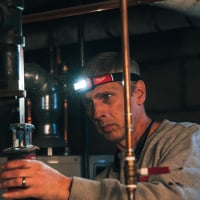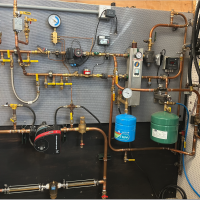Viessmann Vitocrossal 300 CU3A for an old gravity system

The system was installed by the previous homeowner himself with the help of his friends. He was a structural engineer at the architectural firm HOK, and he tells me that HOK's lead HVAC guy specked out the system and determined the required boiler size. Throughout most of the winter, the radiators are around 100 degrees, and even when the temperature is below zero, they are never so hot that they cannot be touched. All three floors of the house stay evenly warm and very comfortable.
I drop a few drops of oil in the three oil ports on the old Taco circulator every few weeks, and so far, both boiler and circulator have performed perfectly. Even during the polar vortex a few years ago, the house remained nice and toasty. Last year, a few pieces of insulation from inside the boiler dropped on top of the burners, but I cleaned it all up right away. There is a dusting of iron rust on the floor of the boiler and inside the burner tubes, which I clean up a couple of times a during heating season. The only repair I have had to do on the boiler was to replace the thermocouple some 20 years ago, but after close to 50 years of service, I think it's a matter of time before something major goes wrong with either the boiler or the circulator.
I have been doing some research on high efficiency boilers, and it seems that the Viessmann Vitocrossal 300 CU3A (199,000 BTU) could be a good fit for an application like mine. I like the concept of a high water volume boiler with large passages. And the heat modulation should obviate the need for several small boilers. Since my old 196,000 BTU boiler has kept the house perfectly warm all these years, I don't see a need for a higher capacity boiler. Viessmann says that this boiler can be dropped right into an old gravity system without the need for primary and secondary piping. And since my system operates at low temperatures, I think that this boiler should be able to achieve a very high efficiency. Also, I really dislike the look of steam coming out of the sides of these old homes when the boilers are exhausted through the side wall (it looks like a dryer running all the time), and if at all possible, I would like to use the existing chimney fitted with a smaller liner. I am planning to use this only for heating and nothing else.
Does anyone here own or has anyone installed the Vitocrossal 300 CU3A on an an old gravity system? If so, what do you think? What kind of circulator did you use? Have you had any issues with the system? And do you happen to have any photos of the installation? Also, would you continue with a high volume, low head pump such as the Taco 110 or B&G 100 series, or would you use something different to achieve a higher Delta T?
I would appreciate any advice before making this big investment. Thank you all in advance.
Comments
-
I'm involved with a current project exactly as you describe. We're using a CU3A to replace a WM, and added the 80g Vitocell indirect.
All 18 radiators were re-valved with TRV's and a mixing valve and motor was installed to heat a basement zone. Additional wall panel rads were installed in the basement. We re-used the existing 4" gravity mains, but had to repipe parts of the returns.
A Vitotrol 300 will be used to control the system. Almost finished and will post pics. I like this boiler, and have used it before.
1 -
Paul, would you use a variable flow pump or something like the low head, high flow Taco 110 that's on the system now?0
-
That's an excellent boiler that will work great with your system.
It was customary back in the day to use large 3 piece circulators like that, but you don't need anything like that energy-hog now that much more efficient wet rotor ECM circs are available. Remember, the system can actually flow from gravity, the circ is really only needed to pump the boiler.
Also, you'll need to line the chimney with PPL or a similar approved plastic. The over-sized SS liner is not gonna work.Bob Boan
You can choose to do what you want, but you cannot choose the consequences.0 -
-
Bob, that was one of the reasons I like this boiler: It has huge water passageways and a place on the bottom of the boiler for any debris to settle down in far away from the burner.
Interestingly, the few times I have drained the system to strip and repaint the radiators, the water has been incredibly clean and clear. The previous owner said that the inside the pipes looked brand new when they installed this WM boiler in the 70s. And that was after almost 80 years in service.
I'm also thinking a wet rotor circulator will be even quieter and more efficient. What would be the advantage of using an ECM circulator vs. a single speed on a one-zone system such as this?
0 -
-
Excellent boiler. Only large mass high efficiency unit that I’m aware of (other than adding a buffer).Got jammed a little on one job, couldn’t get HC1 (with vitotrol 300a) and DE1 to cooperate with each other. The HC was overshooting its set point, pump wouldn’t shut off. Put a regular stat on the main zone and now both zones go to DE1,1
-
-
Paul, do you ever have problems with ferrous particles sticking to the magnet in the pump? Do you use a magnetic separator, and if so, which one would you recommend?Paul Pollets said:I always use ECM pumps for the heating circuits, and fixed 3-speed wet rotor pumps for the indirect tank
0 -
Absolutely do a magnetic separator like a dirtmag. Might do a heat loss on the house to see if you can go smaller with the boiler. Remember the piping is very large so the head is very low, the old circulator was likely moving the water a lot faster than it needed to. The oil cups on the old circulator likely need to be oiled every year to couple years, every few months will result in oil seeping out of the felt.0
-
Thank you! Do you have any experience with BoilerMag? It looks like a very well designed device, out of England. Or would something like a Caleffi DirtMag suffice? I've also been looking at a lot of circulators, and the Taco Viridian VR3452 looks really good to me. I think it might be fun being able to play with different flow rates and see how it affects the system.mattmia2 said:Absolutely do a magnetic separator like a dirtmag. Might do a heat loss on the house to see if you can go smaller with the boiler. Remember the piping is very large so the head is very low, the old circulator was likely moving the water a lot faster than it needed to. The oil cups on the old circulator likely need to be oiled every year to couple years, every few months will result in oil seeping out of the felt.
0 -
Paul, if you were to use this boiler with a steel compression tank (rather than a diaphragm or bladder tank) would you hook the tank up to an air separator on the supply side, or would you connect it directly to the pipe that comes out of the very top of the boiler to which the pressure relief valve and air-vent are to be attached? With the large volume and very slow flow inside the boiler, it seems like that would be where most of the air would come out of solution. My installer isn't that sold on diaphragm tanks, since they need to be recharged and also replaced after a number of years.Paul Pollets said:I'm involved with a current project exactly as you describe. We're using a CU3A to replace a WM, and added the 80g Vitocell indirect.
All 18 radiators were re-valved with TRV's and a mixing valve and motor was installed to heat a basement zone. Additional wall panel rads were installed in the basement. We re-used the existing 4" gravity mains, but had to repipe parts of the returns.
A Vitotrol 300 will be used to control the system. Almost finished and will post pics. I like this boiler, and have used it before.
Have you had any chance to take photos of your Vitocrossal installation?0 -
I would never use a steel compression tank when bladder tanks are superior. Code requires an ASME rated tank on commercial projects, but this project has a floor mounted tank. It's connected to the supply at the air eliminator. I'll take the final pics in the next week. Your installer needs to consider we're in the 21st century. I still see boilers installed with reversed piping and no idea what the PONPC is.0
-
Will your installer replace the current steel compression tank with a new steel tank? If he plans to re-use your old tank, he is being lazy. He should replace it, because your old tank will have lots of rust and sludge that you don't want in your new system.
How do I know this? I just replaced my 70 year old tank (pin hole leak) with a new plain steel bladder-less compression tank from Quality Tanks.
http://qualitytanksinc.com/
Supply houses don't like to carry these because they are slow movers, large and dent easily.
Installers don't like them because they take up room on truck, are heavy, and require periodic draining.
I like my tank because it will outlast any "superior" bladder tank.
I'm really tired of salesmen selling me junk that is "superior" for them, but not me.0 -
-
Here’s a recent install if you’re wanting pics


0 -
He is planning to replace it with a new 40 Gallon B&G steel tank, and also install AirTrol and sight glass.WMno57 said:Will your installer replace the current steel compression tank with a new steel tank? If he plans to re-use your old tank, he is being lazy. He should replace it, because your old tank will have lots of rust and sludge that you don't want in your new system.
How do I know this? I just replaced my 70 year old tank (pin hole leak) with a new plain steel bladder-less compression tank from Quality Tanks.
http://qualitytanksinc.com/
Supply houses don't like to carry these because they are slow movers, large and dent easily.
Installers don't like them because they take up room on truck, are heavy, and require periodic draining.
I like my tank because it will outlast any "superior" bladder tank.
I'm really tired of salesmen selling me junk that is "superior" for them, but not me.
0 -
He said he didn't care for the diaphragm tanks because they lose air and have a finite life. I didn't ask him about bladder tanks, with replaceable bladders.Paul Pollets said:I would never use a steel compression tank when bladder tanks are superior. Code requires an ASME rated tank on commercial projects, but this project has a floor mounted tank. It's connected to the supply at the air eliminator. I'll take the final pics in the next week. Your installer needs to consider we're in the 21st century. I still see boilers installed with reversed piping and no idea what the PONPC is.
0 -
The problem with replaceable bladders is when you need one in 15 years, you may not be able to find just the bladder to purchase.
A new plain steel tank and AirTrol should give you a very long service life. Upside to a sight glass is it will show when the tank needs draining due to water-logging. Downside of a sight glass is an additional leak and air intrusion point. So pick your poison.1 -
Well thanks it’s an upscale 1930s home about 2500 sq ft. We pulled a 1980s 3 gallon/ hour oil boiler which was converted to nat gas which burned 232,000 btu. This Viessmann is 125,000. It once heated a greenhouse and a small garage, but no longer.0
-
Thanks for the tip! I know you're supposed to keep the valved on the sight glass closed unless you're checking the level. I find the whole physics of air management with hydronic systems really fascinating.WMno57 said:The problem with replaceable bladders is when you need one in 15 years, you may not be able to find just the bladder to purchase.
A new plain steel tank and AirTrol should give you a very long service life. Upside to a sight glass is it will show when the tank needs draining due to water-logging. Downside of a sight glass is an additional leak and air intrusion point. So pick your poison.
One thing I have been wondering is whether the tank should attach to an air separator device on the supply side (B), or to to the pipe that comes out of the very top of the boiler and to which an air-vent and pressure relief valve are to be attached (A).
0 -
stick in on B, cake. make the boiler the ponpc0
-
Gary, do you mean A? B is the supply line. A is where the pressure relief valve and air-vent is to be installed. I was thinking with the slow flow through the boiler and the heat right there, most of the air is going to come out of solution right inside the boiler.GW said:stick in on B, cake. make the boiler the ponpc

0 -
Reality is the diaphragm tanks outlast many of the boilers they are connected to these days. Or at least the parts availability. Try and find an inducer motor or circuit board for a 15- 20 year old mod con 🤫
Seem odd to have an expansion device that holds more water than the boiler, maybe the entire piping! Probably get away with a #15 on many systems.Compare the heat loss, cost difference, lack of micro bubble air separation... Becomes obvious why plain steel tanks are not on shelves much anymore.Bob "hot rod" Rohr
trainer for Caleffi NA
Living the hydronic dream0 -
Thanks Bob! It's an old gravity system with probably 200 feet of 3" pipe in the basement alone. I'm not sure exactly how much the pipes and the radiators hold, but it does take a couple hours to fill the system. I find the physics of air-management really fascinating, though I am still not sure whether hooking up the tank to an air-separator and Airtrol completely prevents the loss of air from a compression tank or merely slows it down. I'm not apposed to a diaphragm tank, but the nerdy side of me wants a steel tank.hot_rod said:Reality is the diaphragm tanks outlast many of the boilers they are connected to these days. Or at least the parts availability. Try and find an inducer motor or circuit board for a 15- 20 year old mod con 🤫
Seem odd to have an expansion device that holds more water than the boiler, maybe the entire piping! Probably get away with a #15 on many systems.Compare the heat loss, cost difference, lack of micro bubble air separation... Becomes obvious why plain steel tanks are not on shelves much anymore.0 -
If you connect to the air vent and pipe a small tube to the top of the tank it would work. I have a 500 gallon solar tank that I keep an air bubble up top. I have a Caleffi Discal with a 3/8 copper tube to the top of the tank. There is a thread adapter for that purpose converts the metric thread to NPT..
I believe this engineering guide is online now. Excellent read on the different expansion tank concepts.Bob "hot rod" Rohr
trainer for Caleffi NA
Living the hydronic dream0 -
GW --- why did you use the cast flow checks ? I thought people say the check valve in the pump is the way to go today? I own two properties that have Buderus CI boilers (1994) ,,, if they ever need replacing or I do another project with high mass CI radiators I want to use that boiler0
-
Thanks Bob! I downloaded the handbook a few weeks back after I saw you talk about it on one of your videos. It's excellent. I've gone and seen the systems recently updated for several of my neighbors, and I have not seen one that adheres to the rules that you and Dan Holohan have mentioned. There are a lot of huge new boilers installed for small houses, two boilers each of which is too big for the house and without primary and secondary pumping, air-scoops adjacent to elbows, circulators pumping toward compression tanks, and on and on and on.hot_rod said:If you connect to the air vent and pipe a small tube to the top of the tank it would work. I have a 500 gallon solar tank that I keep an air bubble up top. I have a Caleffi Discal with a 3/8 copper tube to the top of the tank. There is a thread adapter for that purpose converts the metric thread to NPT..
I believe this engineering guide is online now. Excellent read on the different expansion tank concepts.0 -
Agree. But that brings up another question. How did the boiler industry ever allow the government to outlaw their 70 plus year lifespan products for 20 year lifespan products? Good for selling more boilers, good for installing more boilers, bad for consumers.hot_rod said:Reality is the diaphragm tanks outlast many of the boilers they are connected to these days. Or at least the parts availability. Try and find an inducer motor or circuit board for a 15- 20 year old mod con
My plain steel tank is room temp (no heat loss). The boiler stays warm all winter, so not a lot of back and forth between boiler and tank. The heat loss of the boiler is into the building envelope (basement) so not wasted. The tank cost less than a bladder tank. I don't need micro bubble air separation.hot_rod said:Compare the heat loss, cost difference, lack of micro bubble air separation... Becomes obvious why plain steel tanks are not on shelves much anymore.
My proven 70 plus year lifespan Weil-McLain no 57 boiler is less efficient than today's boilers. It has also lasted longer than most, if not all boilers that are sold and installed today. Install labor is not free.
TCO - Total Cost of Ownership
0 -
No I meant B, please see the pic I posted above. I suppose A is just as good though.
@TAG, because, well, because! This was a higher end job, the dough was allocated. Although internal spring checks are incredibly reliable, nothing beats an old-school flow check. Less chance of a check hanging up. By quite a multiplier. If a pump dies, you can open up the check to get some heat moving. If you’re draining the system, you can open up the check. Plus, you got to admit, it looks kind of rad.
Wall lurkers, if you have a zone valve job, you will not have checks.0 -
My plain steel tank is room temp (no heat loss). The boiler stays warm all winter, so not a lot of back and forth between boiler and tank. The heat loss of the boiler is into the building envelope (basement) so not wasted. The tank cost less than a bladder tank. I don't need micro bubble air separation. My proven 70 plus year lifespan Weil-McLain no 57 boiler is less efficient than today's boilers. It has also lasted longer than most, if not all boilers that are sold and installed today. Install labor is not free. TCO - Total Cost of OwnershipWMno57 said:Reality is the diaphragm tanks outlast many of the boilers they are connected to these days. Or at least the parts availability. Try and find an inducer motor or circuit board for a 15- 20 year old mod con
Agree. But that brings up another question. How did the boiler industry ever allow the government to outlaw their 70 plus year lifespan products for 20 year lifespan products? Good for selling more boilers, good for installing more boilers, bad for consumers.Compare the heat loss, cost difference, lack of micro bubble air separation... Becomes obvious why plain steel tanks are not on shelves much anymore.
Probably more the manufacturers not the government. Many products are designed around sunset dates. I doubt any residential boiler has a 70 or even 50 year life cycle engineered into it? Of the 65 brands of boilers currently available, how many will even be in business 20 years from now. Cars, appliances, computers, homes, boilers.. are any designed for 50 year, even 30 year life cycles, anymore?Bob "hot rod" Rohr
trainer for Caleffi NA
Living the hydronic dream0 -
@TAG, because, well, because! This was a higher end job, the dough was allocated. Although internal spring checks are incredibly reliable, nothing beats an old-school flow check. Less chance of a check hanging up. By quite a multiplier. If a pump dies, you can open up the check to get some heat moving. If you’re draining the system, you can open up the check. Plus, you got to admit, it looks kind of rad.
Wall lurkers, if you have a zone valve job, you will not have checks.
Thanks for the explanation GW ... have always previously used them. My current is the first time using a wall boiler and all pex radiant w/ one pump. So I guess my ghost flow is only possible when indirect calling.
0
Categories
- All Categories
- 87.3K THE MAIN WALL
- 3.2K A-C, Heat Pumps & Refrigeration
- 61 Biomass
- 427 Carbon Monoxide Awareness
- 119 Chimneys & Flues
- 2.1K Domestic Hot Water
- 5.8K Gas Heating
- 115 Geothermal
- 165 Indoor-Air Quality
- 3.7K Oil Heating
- 76 Pipe Deterioration
- 1K Plumbing
- 6.5K Radiant Heating
- 395 Solar
- 15.6K Strictly Steam
- 3.4K Thermostats and Controls
- 56 Water Quality
- 51 Industry Classes
- 50 Job Opportunities
- 18 Recall Announcements






